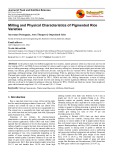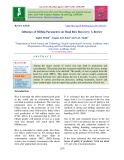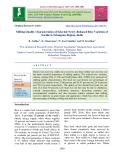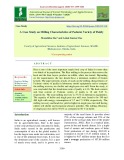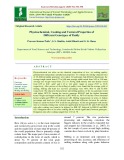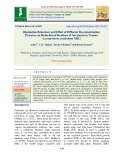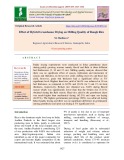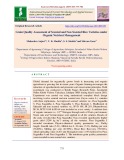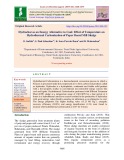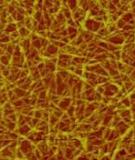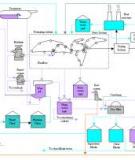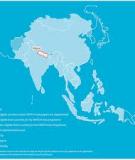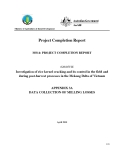
Milling recovery
-
In the present study, four different pigmented rice varieties, namely glutinous white rice, black rice and two red rice varieties (TPS-1 and TKM-9) were evaluated for various quality aspects in terms of milling and physical characteristics such as hulling percentage, milling percentage, whole kernel recovery, milling loss, thousand grain weight, grain volume, bulk density, true density, grain length, grain width and L/B ratio.
 6p
6p  viisac
viisac
 23-09-2023
23-09-2023
 3
3
 1
1
 Download
Download
-
Among the major cereals of world, rice tops both in production and consumption. The production has increased manifolds but the losses during the post-harvest needs to be checked. The quality of rice is judged from the head rice yield (HRY). This paper reviews the various studies conducted affecting the head rice yield during the last 6 decades. It gives a detailed outline of various post-harvest processes, milling treatments, factors and latest technologies used in improving quality and production of head rice.
 18p
18p  gaocaolon9
gaocaolon9
 22-12-2020
22-12-2020
 12
12
 1
1
 Download
Download
-
Brown rice recovery, milled rice recovery and head milled rice recovery are the three essential parameters of milling quality. The selected rice varieties, namely, Anjana (JGL-11118) and Pradhyumna (JGL-17004) were analysed for milling quality characteristics.
 3p
3p  caygaocaolon8
caygaocaolon8
 07-11-2020
07-11-2020
 10
10
 1
1
 Download
Download
-
The paper presents results of study on the milling characteristics of Padmini variety of paddy in laboratory model equipments and to compare the milling recovery in a huller and single pass rice mill. From the study, it was concluded that the slenderness ratio of paddy is 4.16. The husk content and bran content of Padmini variety of paddy is 18 and 5.65 %, respectively.
 6p
6p  kethamoi7
kethamoi7
 26-08-2020
26-08-2020
 6
6
 2
2
 Download
Download
-
Physicochemical test relies on the chemical composition of rice, viz cooking quality, gelatinization temperature and physical properties. To evaluate the milling characteristics of 10 different paddy genotypes were taken. All genotypes had different dimensions, the average length varied from 8.77 to 9.88 mm, average width varied from 2.02 to 3.09 mm, Average test weight varied from 27.12 to 30.19g, Bulk density and true density varied from 0.59 to 0.68 g/ml3 and 1.12 to 1.44 g/ml3 , Angle of repose 29.37 to 32.45 respectively.
 7p
7p  angicungduoc6
angicungduoc6
 22-07-2020
22-07-2020
 9
9
 1
1
 Download
Download
-
Dissipation behaviour of novaluron 5.25% SC was investigated in tomato fruits sprayed at 43.31 (single dose) and 86.62 g a.i. ha-1 (double dose). Tomato fruits samples were collected periodically on 0 (1h after application), 1, 3, 5, 7, 10, and 15 days after application. Average recoveries of novaluron in tomato fruits fortified at 0.01 to 0.25 mg kg-1 levels ranged from 82.20 to 89.47 per cent. The initial deposits of novaluron were 0.30 and 0.56 mg kg-1 at single and double dose, respectively.
 9p
9p  angicungduoc4
angicungduoc4
 26-04-2020
26-04-2020
 11
11
 0
0
 Download
Download
-
Paddy drying experiments were conducted in Solar greenhouse dryer during paddy growing seasons namely kharif and Rabi at three different bed thicknesses (5, 10 and 15 cm). Milling quality analysis showed that there was no significant effect of season, replication and interaction of season and thickness on brown rice yield, milling recovery and head rice yield, however, grain bed thickness had a significant effect at 5% significant level. Highest head rice yield of 66.4% was achieved at 10 cm bed thickness, as compared to 62.9% and 65.4% for 5 and 15 cm beds thickness, respectively.
 10p
10p  caygaocaolon3
caygaocaolon3
 09-03-2020
09-03-2020
 7
7
 0
0
 Download
Download
-
Grain quality assessment of scented and non scented rice varieties under organic nutrient management
Global demand for organically grown foods is increasing and organic agriculture is growing fast in recent years. Organic farming encourages the reduction of agrochemicals and promotes soil conservation principles. Field experiment was conducted at Krishi Nagar, Research Farm, Jawaharlal Nehru Krishi Vishwa Vidyalaya, Jabalpur (MP) during kharif season 2018. Experiment was carried out using randomized complete block design involving twelve scented and non scented rice (Oryza sativa L.) varieties with three replications. An improved scented varieties viz.
 8p
8p  caygaocaolon3
caygaocaolon3
 27-02-2020
27-02-2020
 25
25
 0
0
 Download
Download
-
Hydrothermal Carbonization is a thermochemical conversion process in which a biomass is processed under hot compressed air to form carbon rich products called as hydrochar. Hydrochar is a hydrophobic, condensed and friable solid product with a fuel property similar to conventional non-renewable energy sources like coal and lignite.
 8p
8p  chauchaungayxua3
chauchaungayxua3
 07-02-2020
07-02-2020
 13
13
 0
0
 Download
Download
-
Eleven million tonnes of waste are produced yearly by the European pulp and paper industry, of which 70% originates from the production of deinked recycled paper. Wastes are very diverse in composition and consist of rejects, different types of sludges and ashes in mills having on-site incineration treatment. The production of pulp and paper from virgin pulp generates less waste but the waste has similar properties to waste from the production of deinked pulp, although with less inorganics [...].
 50p
50p  loixinloi
loixinloi
 08-05-2013
08-05-2013
 81
81
 8
8
 Download
Download
-
Traditionally non-wood pulps were produced by alkaline processes. Alkaline processes such as soda (Mohta et al. 1998, Tutus & Eroglu 2003, Feng & Alen 2001, Finell & Nilsson 2004, Okayama & Li 1996) and the NACO process (Recchia et al. 1996, Fiala & Nardi 1985, Paul 2001) have been used to produce non-wood pulp in mills. The main problem with alkaline processes for non- wood fibres is that silicates of non-wood plants dissolve during cooking into the cooking liquor.
 29p
29p  loixinloi
loixinloi
 08-05-2013
08-05-2013
 57
57
 7
7
 Download
Download
-
This paper examines how the effort choices of workers within the same firm interact with each other, and how this interaction depends on the technology of production. In contrast to the existing literature, we focus on showing how the effort choice of one worker can affect the effort choices of his co-workers based purely on income-maximizing considera- tions, rather than relying on behavioral explanations such as peer pressure, shame, etc.
 40p
40p  loixinloi
loixinloi
 08-05-2013
08-05-2013
 43
43
 3
3
 Download
Download
-
Modifications of the dry-grind facility have made the recovery of corn germ possible in dry milling. Normally, neither corn germ nor any other corn fraction is separated out before becoming part of the mash; all components go through fermentation and become part of the feed coproduct, DDGS. Various modifications of the process have made it possible to recover fiber and corn germ—and thus corn oil—from both the endosperm and the peri- carp (outer covering) of the kernel.
 62p
62p  loixinloi
loixinloi
 08-05-2013
08-05-2013
 67
67
 4
4
 Download
Download
-
Though the savings from technological improvements are significant, they tend to be small compared with fluctuations in the net cost of corn, the main ethanol feedstock. This is illustrated in table 2, which presents data on corn costs and profits from the coproduct DDGS (distiller’s dried grains with solubles) in dry-mill ethanol production from 1981-2004. Since 1981, sales of DDGS have recovered nearly half the cost of each bushel of corn used to produce ethanol, peaking in 1986, when over 66 percent of the feedstock cost was recovered this way.
 41p
41p  loixinloi
loixinloi
 08-05-2013
08-05-2013
 46
46
 3
3
 Download
Download
-
Technology-based standards are designed to facilitate the use of known, effective, demonstrated pollution prevention and control technologies. The release standards for new and existing pulp mills in Alberta were adopted after evaluation of technologies and wastewater treatment systems for Alberta pulp and paper mills, and top performing mills throughout the United States and Europe (see Appendix 1). The data for European mills are performance expectations and do not represent the regulatory standards that may be applied.
 47p
47p  loixinloi
loixinloi
 08-05-2013
08-05-2013
 49
49
 2
2
 Download
Download
-
The specific process employed will depend on factors such as the characteristics and constituents of the potash ore and the market specifications. Generally, the ore is reduced in size using a system of crushing and grinding to liberate the different miner- als from each other. This is usually followed by desliming by intense agitation followed by flotation or hydrocyclones to separate the fines consisting of clays, dolomite and sand from the potash ore.
 76p
76p  tieuyeuquai456
tieuyeuquai456
 05-10-2012
05-10-2012
 39
39
 1
1
 Download
Download
-
The collection of data milling damage in the two provinces for more than three mills each province (Kien Giang and Tien Giang) were made in 2007-2008. Undertaking the recovery of rice will not only depend on the initial quality of rice (existing cracks or major cereals), but also on the effectiveness of the milling operation. So, in this work, the fact milling loss of data is collected in two provinces of Tien Giang and Kien Giang. There exist three system of rice plants in both provinces:
 20p
20p  xau_la
xau_la
 10-02-2012
10-02-2012
 69
69
 6
6
 Download
Download
CHỦ ĐỀ BẠN MUỐN TÌM









